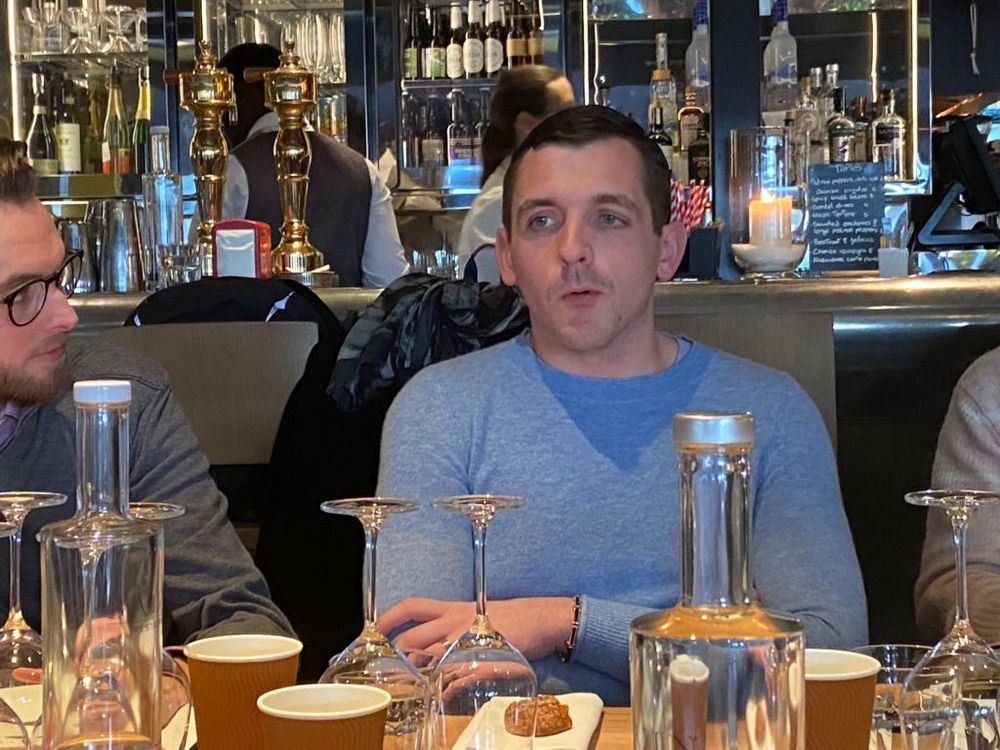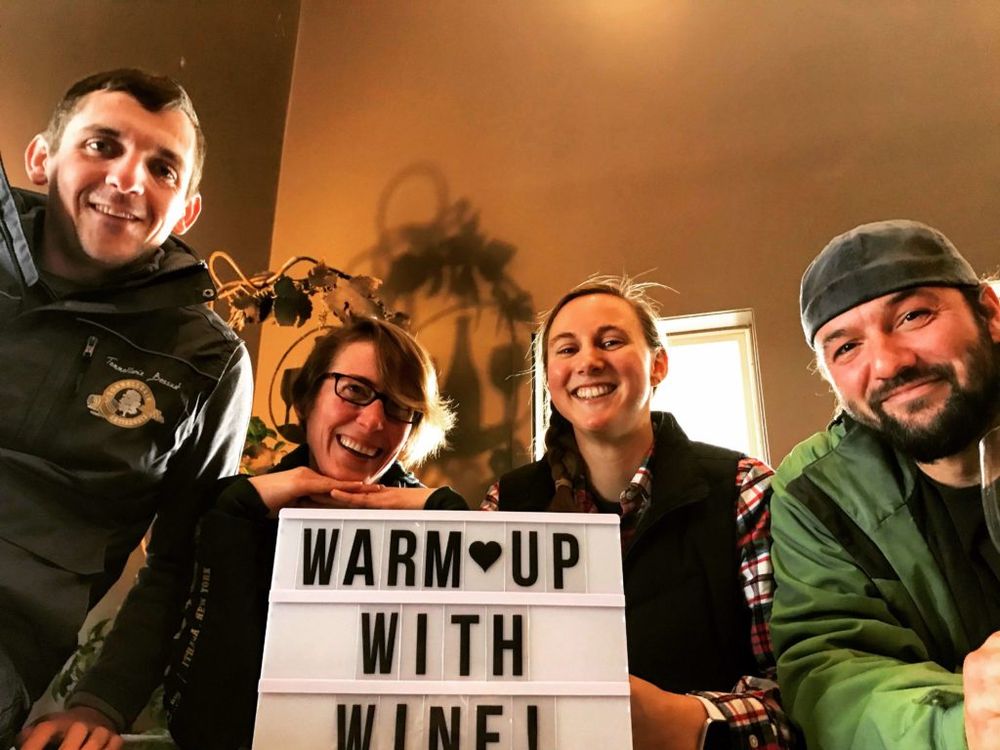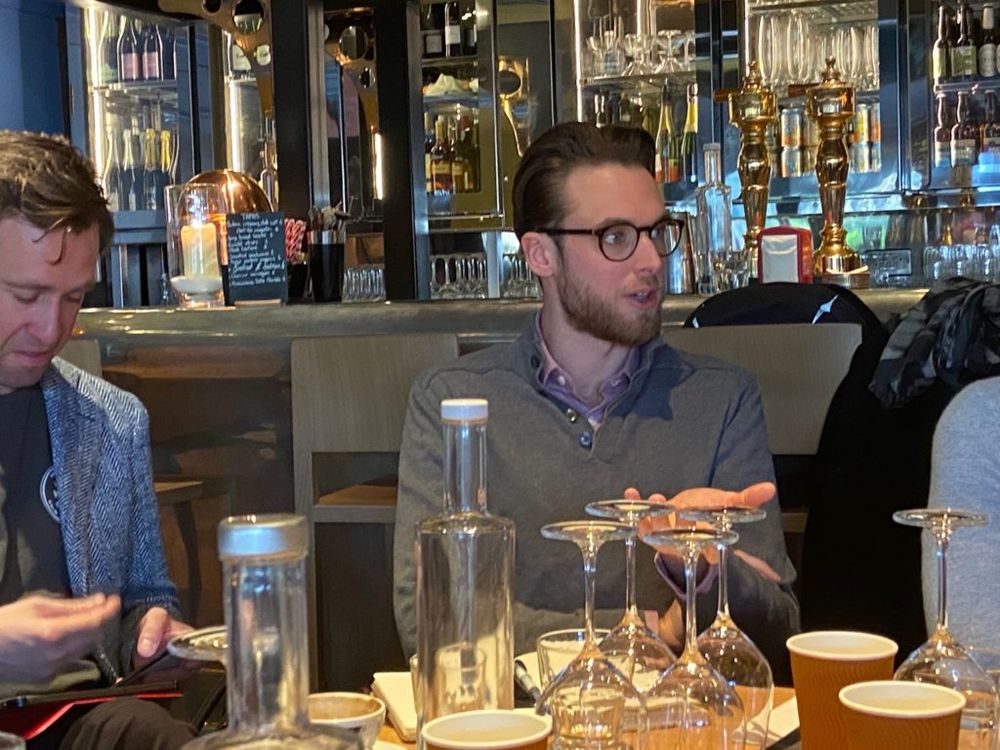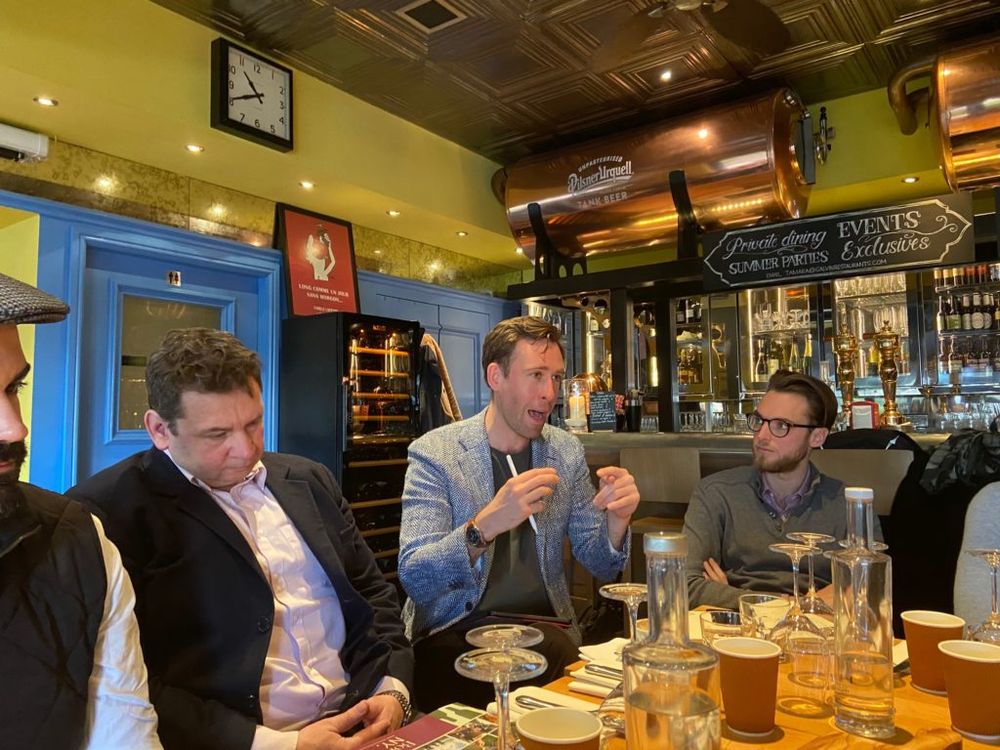With The Buyer debates we look to give top UK wine buyers the chance to get a better understanding of a specific region or country by allowing them to taste a cross selection of wines and styles as well as the opportunity to share ideas and thoughts with fellow buyers and producers from that region. You can read Part One of our New York State wines debate here.
You can’t have a debate without a panel and we were fortunate to have some of the leading voices and businesses represented at our New York State wine debate, held the week before the country’s lockdown for Covid-19.
From New York State itself we were able to have the expertise of two highly influential New York State wine producers:
- Kelby Russell, winemaker, Red Newt Cellars
- Jennifer Menges, director of operations, for Hermann J Wiemer
The Buyers’ Panel

Richard Ellison of Wanderlust Wine and Mattia Scarpazza of Petersham Nurseries taking part in the pre-debate tasting (spot the Hitchcock style appearance of the writer…)
The line-up of UK buyers included importers who are already working with New York wines and those who still had them on their ‘to do’ list.They included:
- Maggie Macpherson, group buyer, Jeroboams.
- Mattia Scarpazza, head sommelier, Petersham Nurseries.
- Daniel Lambert, founder, Daniel Lambert Wines
- Richard Ellison, founder, Wanderlust Wines
- Keith Kirkpatrick, wine buyer, Roberson Wines
- Elliot Awin, partner, ABS Wine Agencies
- Lucy Perbellini, wine buyer, Liberty Wines
- Richard Lewis, Enotria&Coe
- Matt Ellis, marketing manager, Top Selection Wines & Spirits
- Dan Belmont, education manager, Bedales
Balancing act

Kelby Russell from Red Newt Cellars was able to bring to life the excitement in New York State wines taking place in the US that he hopes can now come to the UK and Europe
Eliot Awin at ABS picked up on the theme developed in the part one write up of the debate when he understood the dilemma that some producers might have “in growing and making wine that are right for the region” but are not so obscure that it makes them too hard to sell. For after all UK buyers are, by their own admission, guilty of constantly asking to see new wines, particularly those that are true and authentic to the soils of that particular wine area, yet at the same time wanting to have wines that easily identifiable and easy to sell.
“How much do you push these new developments with what really works in the market? Do you have to fund them with Cabernet Francs and Rieslings that are really marketable?” he asked. “How do you get that balance right?”
Conversely Maggie Macpherson at Jeroboams said she was actually “more interested in the native and hybrid varieties now that I have heard the history and traditions behind them”. She felt they might be an easier story to tell, and stand out, particularly in the retail arena, where it has been proved time and again how hard it is to sell Riesling.
“The sustainability factor is also really interesting and the fact you don’t need a lot of intervention with them is what consumers are looking for,” she added. “If I get a Chardonnay or Pinot Noir from New York State I am going to compare it immediately with all the other countries that make those wines. Whereas if there is a grape variety I have never heard of, that has a sustainability factor and has all the history, that is something that is more interesting to me from a retail point of view. All our shop staff can get super excited about it and they can then tell their customers about it. Then the chain reaction happens.”
One of the key reasons why native varieties have become so popular amongst some producers is they are so consistent, safe and affordable to grow, said Kelby Russell of Red Newt Cellars.

Kelby Russell, left, with some of the rest of the Red Newt team
But he was also keen not to also overplay their role and that often a producer might only produce one wine with a native variety as their nod to the traditions of the area, rather than relying on it for their livelihood.
Jennifer Menges said there was now a real growing demand and interest in these more left field and experimental wines in the US. “We see a lot of foot traffic from people coming to the region both from New York city and neighbouring states.”
In fact New York was by far the biggest market for the winery she works for – Hermann J Wiemer – both in on and off-trades. “We also do a lot of DTC shipping as well. A lot of these wineries have started to get a cult following now, including for these more quirky wines.”
She was also keen to stress that although these style of wines might sound a little left field, the producers making them still apply the same quality thresholds and care and attention as they would a more familiar grape variety. “They are going to apply the same winemaking techniques as they do with Cabernet Franc or Riesling. They are trying to elevate these varieties.”
And some wineries are doing so with big enough productions to try and push them out for export, she added.

Hermann J Wiemer is well placed to build on its reputation the US now in exports, says Jennifer Menges
Chance to show the world what we can do
Mattia Scarpazza of Petersham Nurseries felt there was a clear opportunity for some producers to do both. To focus their local style wines on the domestic scene and then offer the more marketable wines to the international market.
Daniel Lambert was interested to know what the primary reasons were for producers that can sell their wine domestically to want to or need to export at all?
Menges said a lot of it came down to “brand recognition” both for individual producers, but also for the region as a whole. “You develop a pride for the wines you have made and what we have accomplished and we want to show the world that,” she added. “We have found success in a lot of different markets. Hong Kong is a great market for our Rieslings. Japan too. They just eat them up. A lot of us just want to show off our region and show off our wines.”
Russell also said there is a bit of a “fallacy” about New York State wines that the city of New York is such a strong market. The opposite is actually the case. Sommeliers and restaurants are far more open to wines from around the world than they are to the producers up the road. It has meant wineries have always had to look to their local market or to other states and overseas for their sales.
“You have had to commit internationally from day one,” said Lambert.
Tasting the wines

Mattia Scarpazza urged producers to bring both their more left field and their more traditional wines to the UK
Maggie Macpherson said she was really taken by the Cabernet Franc style she tasted during the debate: “It’s just such a refreshing style. It’s what’s on trend at the moment. A lower abv, crunchier style of fruit, rather than the big 15.5% blockbusters that get tired very quickly. It’s what consumers are looking for at the moment.”
Awin said he really liked the differences he was able to taste across the Rieslings, particularly the ones that were a little more reductive in style.
The key there, said Russell, is the type of soils that the Rieslings come from, which is why he believes the winemaking in New York has so much more in common with the Old World. Where terroir has so much more bearing on the fruit and the style than what you might see in California.
“Riesling is so transparent to its terroir,” he added.
Which was music to Awin’s ears as he was thinking of regions of Germany, like the Rheinghau, as he was tasting the wines. “We have a portfolio of 200 Rieslings from Germany and the reason why we do that is because of the soil differentiation there is,” he said.
Russell said that’s also where one of the big changes has come amongst producers in the Finger Lakes region: “People are much more comfortable about what their site is good at. They are all equally accomplished and different expressions of Riesling.”
Clearly some of that reputation comes from the winemaker, but ultimately different soils and areas are becoming known and recognised for the style of Riesling they are producing. “We spend a lot of time tasting each other’s wines blind,” said Russell. “We all bring our tank samples. Everyone is friendly and open and remarkably so. But it’s hard to do a blind tasting as we all know our styles so well.”
“That’s great,” said Awin. “As diversity is such a great thing.”
Final thoughts

Richard Ellison said it was vital producers understand what different importers can do for their business and their wines
“Market awareness is the number one for me. Know what the market wants and then price your wines accordingly to what is already selling and try and compete at that level then you should get in,” said Lambert. “Don’t keep it London centric as the rest of the country would be interested in these wines.”
Richard Ellison at Wanderlust Wines said as well as doing your homework about the UK market, it’s also vital producers really understand the different importers and what they can do for you. “Have a really good idea of why you would be partners with each other. How does your wine fit into the rest of my portfolio. That’s what I need to know.”
Keith Kirkpatrick at Roberson Wine said a good guide for any producer looking at the UK is to take their retail pricein dollars in the US and then transfer that into pounds and that is the price that a UK importer will sell into a restaurant excluding VAT. Then multiply that by four to get the restaurant list price.
“Then ask yourself would you sell your wine at that price?” said Lambert. “If not change your price to us. Our Canadian importer did that and had to give us a 40% discount. We are now doing pallet after pallet. If they had gone in at the Canadian price we would not have sold half a pallet. It’s a bitter pill to swallow.”
Kirkpatrick was also pleased to hear from Ellison that the logistics of bringing wine from New York was actually a lot quicker than from the west coast, with a number of shippers operating out of New Jersey with lead times of around three to six weeks
Macpherson said she had found it a really useful exercise, particularly having the chance to taste so many wines. “It’s the first time I have been able to have a comprehensive tasting of New York wines and the more there are, the more it becomes normal to see New York wines here. We are all sheep in the trade and once one person has one then more people will start thinking the same. Keep going. But be aware of pricing.”
For Awin it’s vital “everyone is singing from the same hymn sheet” and “pulling in the same direction”. “Doing a wall of Riesling at a tasting and having a cohesive story to get behind.”
- You can catch up with the first part of our New York State buyers’ debate by clicking here.










































